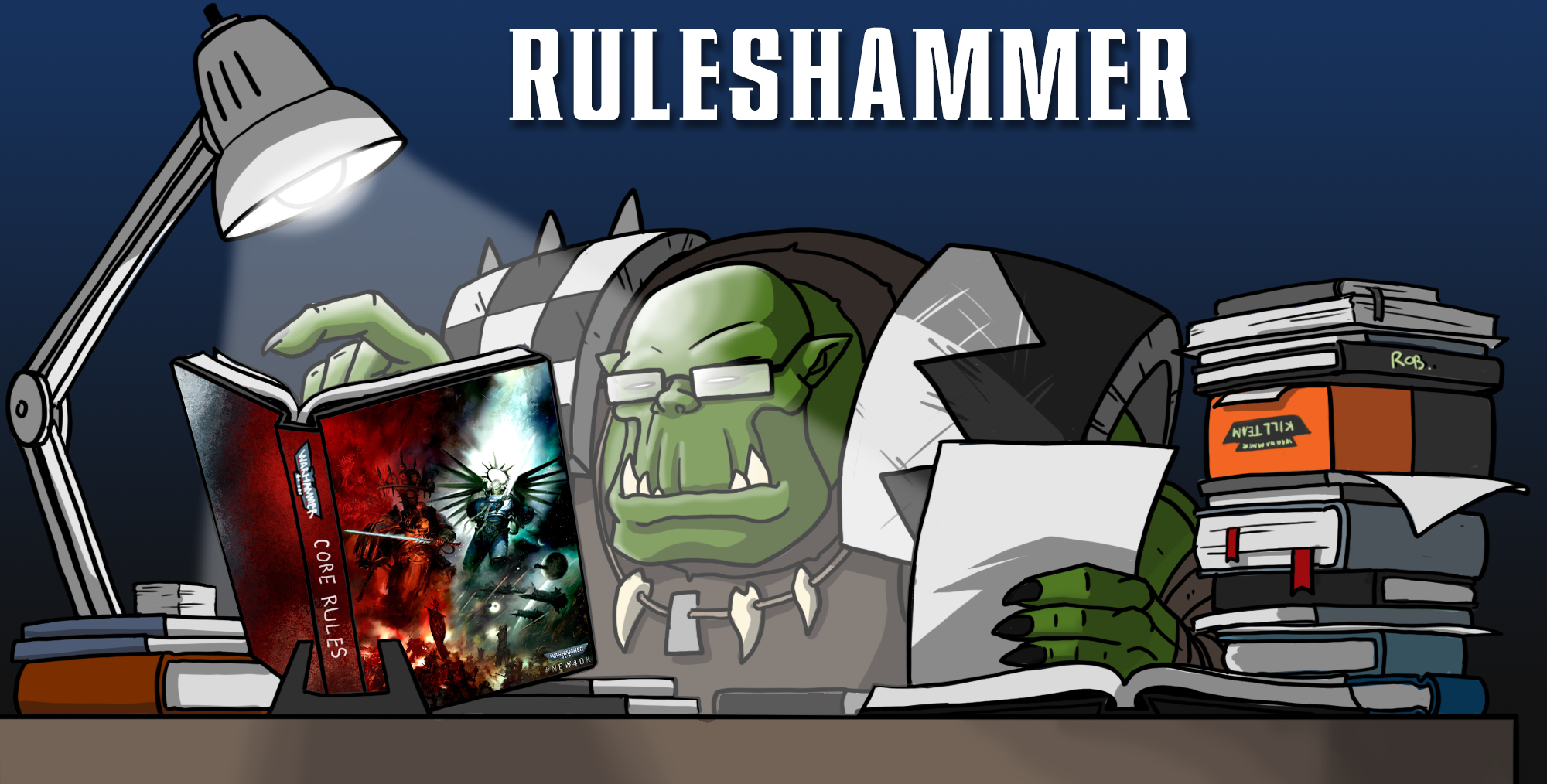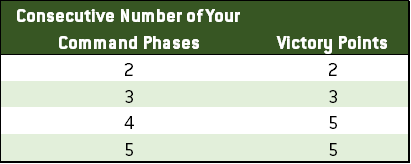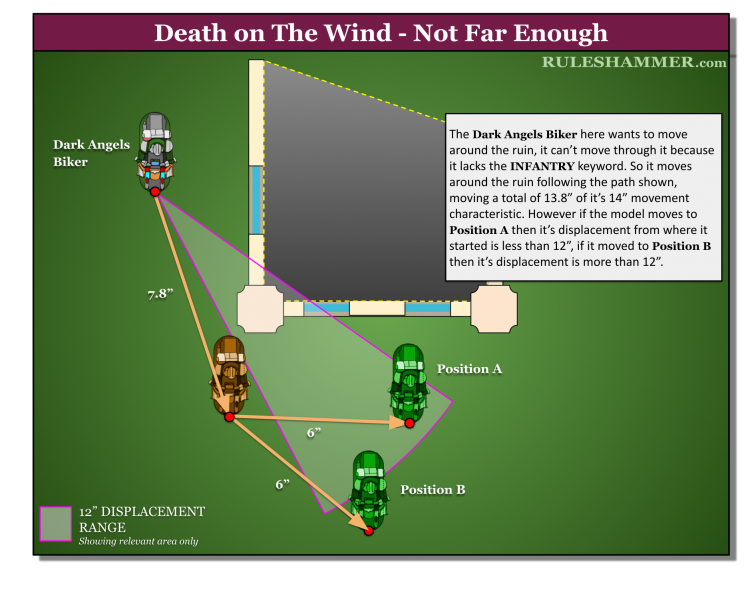Welcome to Ruleshammer! In this article we’re going to cover some of the more complicated or ambiguous rules for 9th edition’s Codex: Dark Angels, and address some common questions and points of confusion players have brought up since the book’s release.
Current Q&A
Successor Chapters
Successor Chapters for the Dark Angels are a little more complicated than they are for some of the other chapters, owing in part to some quirks around the chapter’s unique rules. Let’s cover each one of the chapter’s special rules and whether they apply to Successors:
Sons of the Lion (Super Doctrine)?
Like other chapters’ successors, Dark Angels’ successors gain the Dark Angel’s “super doctrines” without any complications.
Inner Circle or Jink?
This one is a bit more complicated – Units with the DEATHWING or INNER CIRCLE keywords gain this ability if they are in a Dark Angels Detachment. They also gain these abilities if they are in a Dark Angels Successor chapter detachment, but with a catch:
DETACHMENT ABILITIES: If you have Dark Angels successor Chapter, then for the purposes of using any Dark Angels Detachment Rules, you can replace the DARK ANGELS keyword in all instances with the name of your successor Chapter. (Codex: Dark Angels, pg. 40)
This means that Dark Angels Successor chapter detachments will gain the Inner Circle and Jink abilities. However, to actually use the ability there’s another requirement – both the Inner Circle and Jink special rules have this text before listed what they do.
If this unit has the Grim Resolve Chapter Tactic, or has the Inheritors of the Primarch Successor tactic and it is using the Chapter Tactic of the Dark Angels, then: (Datasheets, Codex: Dark Angels, pg. 61)
So while your Dark Angels Successors will get the Inner Circle and Jink abilities, neither of these abilities will actually work for them unless they’ve taken the Inheritors of the Primarch Successor Tactic with the Grim Resolve tactic as their selected tactic.
Ravenwing and Deathwing Detachments in a Successors army?
There are no extra requirements for successors to make use of the 1st Company or 2nd Company abilities. Unlike Inner Circle or Jink the army does not need to be using the Grim Resolve chapter tactic to make use of these detachment bonuses and changes, so if you’re running a Successor, feel free to build around these.
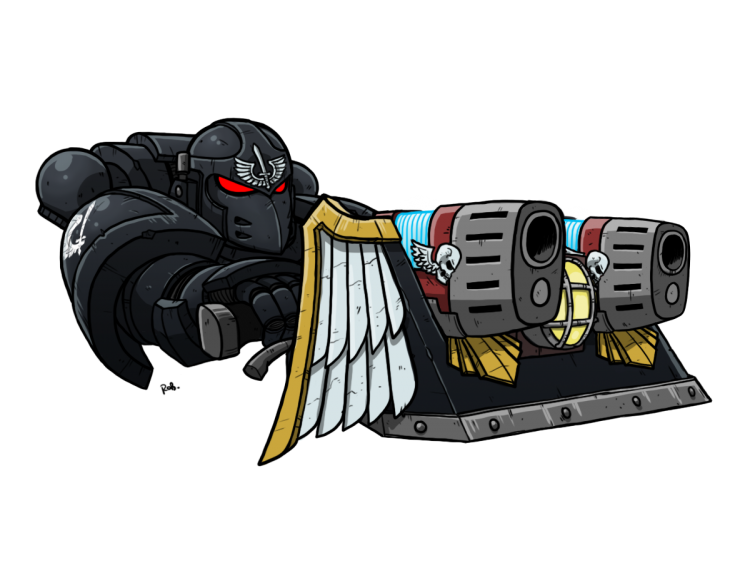
The Hunt Stratagem – Using it multiple times
The Hunt is a Stratagem used before the first turn begins. As such, you can use this multiple times before the battle begins.
Use this stratagem at the start of the first battle round, before the first turn begins. Select one RAVENWING unit from your army. That unit can make Normal Move as if were your Movement Phase, but it must end that move more than 9″ away from any enemy models. If both players have units that can move before first begins, the player who is taking the first turn move their units first. If that unit contain 5 or fewer models, this Stratagem costs 2CP; otherwise, it costs 3CP.
One thing missing from this stratagem though is any specific restriction against picking the same unit twice. I wouldn’t recommend playing that you can do it twice, as that doesn’t seem intended but a limit on this in the FAQ would be beneficial (Rob’s Note: This is the same issue that the World Eaters’ Stratagem Apoplectic Frenzy has. Given we’re more than a year past the publication of Faith and Fury, I wouldn’t count on this getting an FAQ).
Grim Resolve and Steady Advance – does this work?
I’m going to preface this section by declaring that I do not know for sure how these two rules interact. It’s super frustrating to still have two terms around remaining stationary especially when one of them is in a 9th edition codex! As with other times we’ve covered this topic, the challenge revolves around whether effects that require you “not move” will trigger off effects that cause you to count as Remaining Stationary. First let’s look at the part of Grim Resolve that matters here.
Each time a model with this tactic makes an attack, unless that model’s unit has moved this turn (excluding Pile-in and consolidation moves), add 1 to that attack’s hit roll.
And then the Steady Advance stratagem from Codex Space Marines:
Use this Stratagem in your Movement phase, when an ADEPTUS ASTARTES INFANTRY unit from your army makes a Normal Move. Until the end of the turn, that unit is considered to have Remained Stationary.
So does counting as Remain Stationary meet the criteria for Grim Resolve? I think I’d say that it does but I’d really like an FAQ to make this clear; the definition for Remain Stationary is really rather weird. It’s worded that it prevents movement, rather than being the state of having not moved:
If a unit Remains Stationary, none of its models can be moved for the rest of the phase. Any units from your army that were on the battlefield and were not selected to move in the Move Units step of the Movement phase are assumed to have Remained Stationary that phase.
Based on the latest FAQ though, there is the implication that counting as Remain Stationary at the very least is equivalent to counting as if the unit has not made a Normal, Advance or Fall Back move this turn.
Transports and Rules that Count as Remaining Stationary
Some rules allow a model to count as having Remained Stationary, even if that model has moved during its Movement phase. Even if a Transport model is subject to such a rule, embarked models still cannot disembark from that Transport model during the Movement phase if that Transport model has already moved, unless that Transport model (or the models embarked within it) have a rule that explicitly allows them to disembark after the Transport model has moved.
If Remain Stationary didn’t at least mean that much then this Rare Rule blocking disembarking from a Transport that counts as Remain Stationary would be unnecessary.
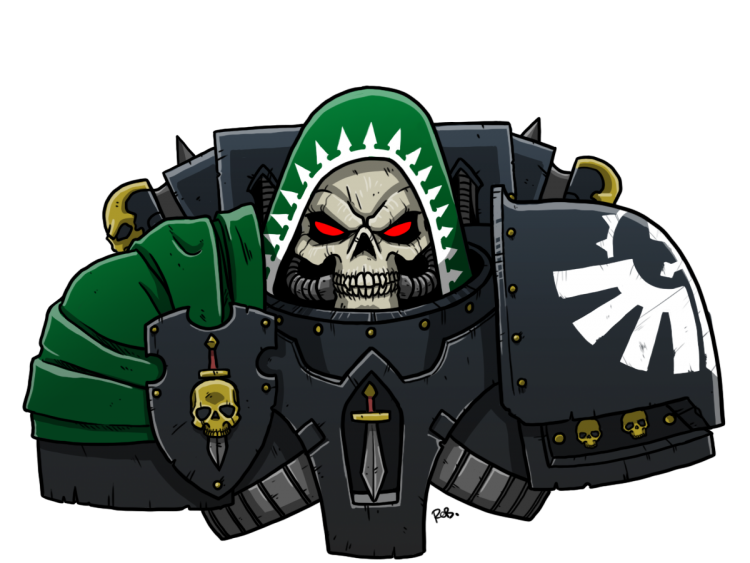
Calibanite Knight vs Inner Circle (or Transhuman Physiology)
One of the new Dark Angels Warlord traits is Calibanite Knight, which gives your Warlord the following ability:
Each time this WARLORD makes an attack against an INFANTRY or BIKER unit, an unmodified wound roll of 2+ is always sucessful.
But what if you’re facing another army of Dark Angels? Or another chapter of Space Marines that have used the Transhuman Physiology Stratagem? Lets look at the relevant part of the Inner Circle ability.
Each time an attack is made against this unit, if this unit has the INFANTRY keyword, an unmodified wound roll of 1-3 always fails, irrespective of any abilities that the weapon or the model making that attack may have.
Both Inner Circle and Transhuman Physiology have this extra line that means they always work and always wound on abilities have no affect on them. If they did not have this line however, this would be an actual example of a conflict that the rare rule Attacker’s Priority applies to. There’s no resolution to 2+ always succeeds vs 1-3 always fails; they directly contradict each other, unlike rules such as Omni Scramblers which does not contradict deep strike distance requirements (there are points on the board that are more than 12″ and more than 9″ away so that’s where models affected should go). Attackers Priority actually applies quite rarely in practice.
Stubborn Defiance – how does this work?
One of the Dark Angels’ new custom Secondary Objectives is Stubborn Defiance, a Battlefield Supremacy objective that rewards you for holding the same objective marker for multiple turns with Objective Secured units. There are a few quirks to review here, however. Let’s start by looking at the rules text:
In your first command phase, select one objective marker. At the end of each of Command Phase after the first, if you control that objective marker with a DARK ANGELS unit from your arm that has the Objective Secured ability, score a number of victory points based on the consecutive number of Command phases that you have controlled that objective marker with that unit as follows:
For example, in your third Command Phase, if you have controlled that objective marker with a DARK ANGELS unit for three of your Command phases consecutively, you will score 3 points on that turn.
I really wish the example covered this specific thing but the first question I got about this secondary objective was about if it has to be the same unit or any unit that controls the point. Based on this part of the rule though:
consecutive number of Command Phase that you have control that objective mark with that unit
I’m fairly confident that it’s the same unit required for each turn. You can still have multiple units on the Objective though and score based on either of them, or the one that has been there the most turns. What I’m a little concerned by still though is how open this is to be interpreted that you can score it for each Dark Angels unit on a point; I don’t think the objective actually allows for that but it’s easily debatable that it does based on the wording.
Abilities Potentially Missing the Aura Flag
I have spotted a few abilities that might be missing the Aura flag that should probably have it.
Reliquary of the Repentant:
Raven Wing Model only. While an enemy unit is within 3″ of the bearer, each time an invulnerable saving throw is made for a model in that unit that has invulnerable save of 4+ or better, the saving through is only successful on an unmodified roll of 5+. [Supplement Dark Angels Pg48]
and the litany gained by the Cup of Retribution
Feast of Malediction: While a friendly DARK ANGELS CORE unit within within 6″ of this PRIEST, add 1 to the Attacks characteristic of the models in that unit.
Both of these abilities meet the definition of Aura abilities in the core rules;
Some abilities affect models or units in a given range – these are aura abilities. A model with an aura ability is always within range of its effect. The effects of multiple, identically named aura abilities are not cumulative (i.e. if a unit is within range of two models with the same aura ability, that aura ability only applies to the unit once).
Both of the effect models or units while within a given range. They don’t have any of the usual distinctions of a none aura, such as affecting models outside a range such as the Raven Guard chapter tactic or Omni Scramblers. The effect also doesn’t continue to apply after leaving the range such as with Tau’s Mont’ka or Necron obeisance generators.
Grim Resolve and Steady Advance – does this work?
I wrote a lot about this interaction before to come to the conclusion that I wasn’t sure. I think the new FAQ though does resolve this and the answer is that it works. Here’s a reminder of what Grim Resolve does
EACH TIME A MODEL WITH THIS TACTIC MAKES AN ATTACK, UNLESS THAT MODEL’S UNIT HAS MOVED THIS TURN (EXCLUDING PILE-IN AND CONSOLIDATION MOVES), ADD 1 TO THAT ATTACK’S HIT ROLL.
And then the Steady Advance stratagem from Codex Space Marines:
USE THIS STRATAGEM IN YOUR MOVEMENT PHASE, WHEN AN ADEPTUS ASTARTES INFANTRY UNIT FROM YOUR ARMY MAKES A NORMAL MOVE. UNTIL THE END OF THE TURN, THAT UNIT IS CONSIDERED TO HAVE REMAINED STATIONARY.
So how does the new Remain Stationary FAQ address this?
RULES THAT COUNT AS REMAINING STATIONARY
SOME RULES ALLOW A UNIT TO COUNT AS HAVING REMAINED STATIONARY, OR COUNT AS IF IT HAD NOT MOVED, EVEN IF THAT UNIT HAS MOVED DURING ITS MOVEMENT PHASE. THE FOLLOWING RULES APPLY TO THESE TYPE OF RULES:…
5. SUCH RULES MEAN THAT ANY OTHER RULES (ABILITIES, STRATAGEMS ETC.) THAT ARE USED OR TRIGGERED WHEN A UNIT REMAINS STATIONARY (E.G. GRINDING ADVANCE) CAN BE USED/ARE TRIGGERED.
The rare rule establishes pretty clearler that “having Remained Stationary” is equivalent to “count as if had not moved”, meaning that I feel these terms are finally interchangeable without too much debate. This really helps with some older rules. As Grim Resolve is a rule triggered if the unit hadn’t moved this turn, counting as Remaining Stationary is now pretty clearly the same thing, so it triggers. This does mean that the unit would have +1 to hit with attacks in a turn it charged, as it counts as remaining stationary for the entire turn. You still ccan’t use Steady Advance to gain either Advance and Charge or Fall Back and Charge, however, as the stratagem can only be used on a unit that has made a Normal Move.
Advancing but staying still for Jink and measuring moves for Death on the Wind
Jink Still Easy
Jink can still be gained without actually changing position, for the 5++ version as when doing a Normal move 0″ is less than your move characteristic, the model still counts as having moved though. Similarly advancing for the 4++ invulnerable doesn’t require the models actually move anywhere but once it’s declared they count as having Advanced even if they remain in the same physical place on the board.
Death on the Wind got sensible
As a reminder here’s the text of the secondary objective:
Score 2 Victory Points each time an enemy unit is destroyed by an attack made by a Ravenwing model from your army that moved 12″ or more during the movement phase of that turn, or made a charge move that turn.
Previously there was no rule on the 12″ requirement that clarified if the 12″ needed to be total distance moved or displacement. So many argued that a model could move 6″ forward and 6″ back and be a valid unit to score VP for this objective. Not any more.
Moved x” or more: Some rules require a unit to move x” or more, or are triggered when a unit moves x” or more, where x is a specific value listed in the rule itself. In both such cases, it is the displacement between the start and end of the move that is being referred to, and not the total distance moved. For example, in the former case, such a rule requires all parts of every model in the unit to end their move at least x” away from where they started. In the latter case, such a rule is triggered when all parts of every model in the unit have ended a move at least x” away from where they started.
It’s now specifically the displacement. Though this does make the objective significantly harder to score. It’s very possible when moving around terrain with units like bikes to move more than 12″ but end less than 12″ displacement from where they started.
Have any questions or feedback? Got a rules question you want answered? Drop us a note in the comments below, ask a question in our Ruleshammer form, or head over to r/ruleshammer to discuss.
